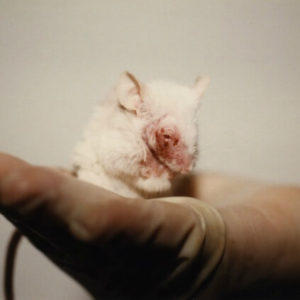Over 100 million animals die every year as a part of the animal testing. A big portion of animal testing is funded by cosmetics companies to test “new” ingredients in various makeup, haircare and skincare products to ensure that it’s safe for human use. Many modern, effective and cruelty free methods have been developed to test products for skin and eye irritation, therefore rendering animal testing for cosmetics unnecessary. This page will give you an overview of the practices commonly used in animal testing, explain why animal testing is ineffective and present the new alternatives that have been developed in the past decade. This is just a small glimpse into the ugly side of the beauty industry, and while it’s a good starting point for those of you considering making the transition, we suggest you do more research on your own.
What happens during animal testing
- A variety of animals are used in animal testing, including monkeys, guinea pigs, bunnies and dogs.
- Animals are burned, crippled, starved and drowned without any form of pain relief.
- Most animals are never able to recover from the emotional distress and physical pain they’ve endured.
Cosmetics tests are most often conducted on bunnies, guinea pigs and mice, although dogs and cats are used in other forms of scientific “research”. Animals living in experimental laboratories are bred and live their entire lives in captivity. U.S. law allows these animals to be poisoned, starved, isolated, burned, drowned and brain-damaged without any form of pain relief. None of these tests are required or even necessary since thousands of ingredients have already been proven to be safe for human use.

To test whether a product will irritate the skin, chemicals are vigorously rubbed into the shaved skin of an animal and the area is covered with a patch. After up to four hours, the patch is removed and the remaining substance is wiped away. The animals are given up to 14 days to see if a wound develops on the infected area. These tests can cause animals to suffer from ulcers, inflammation, bleeding and bloody scabs. At the conclusion of the test, the animals are killed by either neck-breaking, suffocation or decapitation. Let’s take a pretty typical case for example. During a sight deprivation experiment in University of California, Riverside, a monkey had his eyelids sewn shut and a device implanted in his head. The Animal Liberation Front (ALF) raided the facilities and rescued the highly distressed monkey. The university pretended like the eye damage was caused by a veterinarian from the ALF, as to avoid facing legal problems, and the head device was purposefully impaired by the ALF to further their case. The university faced no legal consequences and the monkey was never able to recover.
A common technique used to test how much of an ingredient would be too dangerous to put in a product is lethal dosing. Essentially, animals are forced to swallow massive amounts of a test chemical to determine at what point it will cause death. This process if extremely painful and the animals experience an immense amount of agony as their bodies slowly deteriorate. These are just a few ways in which animals are exploited and tortured in the process of testing a cosmetics product. Contrary to popular belief, most of the time these animals don’t just get released into the wild or get adopted by loving families after they are deemed useless because they are not able to cope and survive in normal living conditions. Companies might lead you to believe that animals are euthanized quickly and “humanely”, but that couldn’t be further from the truth. In some instances, an animal might be put into a chamber where it inhales a toxic gas. The most common method of disposing of an animal is to use physical force such as decapitation or breaking an animal’s spine. This method is most commonly used on small animals. Other times, animals are just shot to death.
Why animal testing is outdated and ineffective
- Over 90% of animal experiments fail to produce useful results.
- Over $28 billion/year is wasted on animal experiments in the United States.
- Animal testing is illegal in more than 30 countries, including all of Europe.
Alternatives to animal testing are often cheaper, quicker and more accurate. The National Institute of Health wastes over $12 billion a year on research that simply does not work. Over 90% of animal experiments fail to lead to treatments for humans and over 95% of pharmaceutical drugs that are deemed safe for animals fail in human clinical trials. Furthermore, 89% of animal studies could not be reproduced. This means that, conservatively speaking, about $28 billion per year is wasted on experiments that don’t lead to anything – no new treatments or products are developed as a result of all of this money and animal torture.
Let’s talk about specifically cosmetics testing. The skin of a rabbit is vastly different than the skin of a human being and if a product doesn’t react to the rabbit’s skin it does not mean that it is okay to be used on human skin and vice versa. There is so much room for error and inaccuracy in animal testing that it just seems ridiculous to keep wasting billions of dollars on this unnecessary torture of innocent animals. That’s exactly why animal testing has been banned in Norway, Israel, India and all 28 member states of the European Union. Europe has already demonstrated that it’s possible for cosmetics companies to keep innovating, developing new formulas and succeeding in the beauty industry without having to hurt animals. So what is the United States waiting for? Are our politicians really that corrupt that they refuse to even consider a bill that saves thousands of animal lives and helps develop safer products?
Alternatives to Animal Testing
- Over 40 non-animal tests have been validated for cosmetics testing.
- Most of these cruelty free tests are cheaper, quicker and more accurate.
- These tests are already being widely used in Europe.
The way most cruelty-free skincare and makeup companies develop their products is by using some of the thousands of ingredients that have a long history of being safe to apply to human skin. There is an abundance of existing safety data that proves these ingredients to be non-harmful and as such, there is no need for any further testing. Over 40 non-animal tests have been validated for use for cosmetics testing and can provide much more accurate results. There is a growing number of skin tests available that use human deconstructed skin, such as Epiderm, EpiSkin and SkinEthic. EpiSkin and EpiDerm are both models created from the cultures of human skin sells, crafting a layered model suitable for skin corrosion testing. EpiDerm is also able to test of toxicity. This method was approved by the European Coalition on the Validation of Alternative Methods (ECVAM) as a complete substitute for animal tests.
Another one of the many animal testing alternatives that has been developed is called Genoskin. Genoskin SAS is a company based in France that was founded in 2011 and it provides unique human skin models for cosmetic product testing. Genoskin utilizes donated human skin tissue collected after plastic surgery and keeps the samples alive in a standardized ex vivo culture system. Unlike animal skin or skin replicas that are grown in laboratories, Genoskin’s skin tissue model contains real human skin which is much more effective for testing potential skin irritation of various skincare and makeup products than animal skin. The company has recognized that animal testing is unethical, inefficient, time consuming and expensive so they developed what they believe to be a revolutionary model. They have established an office in Boston and plan to open a local production unit by the end of 2018.



